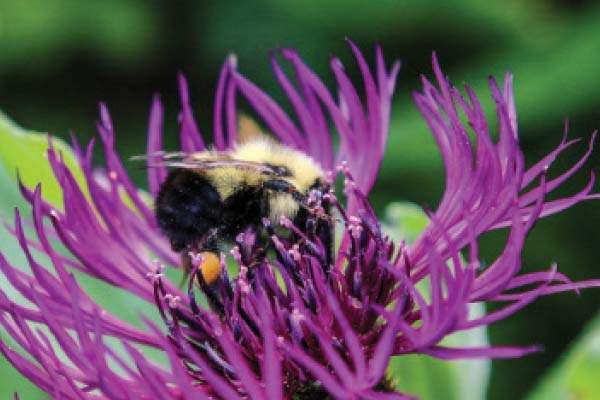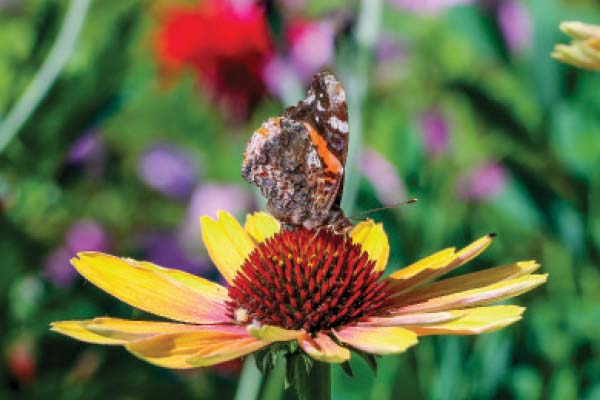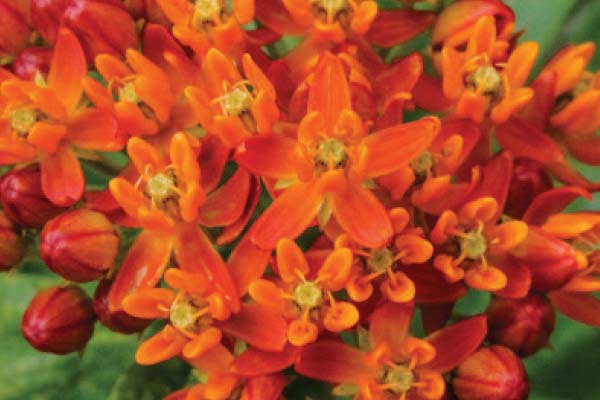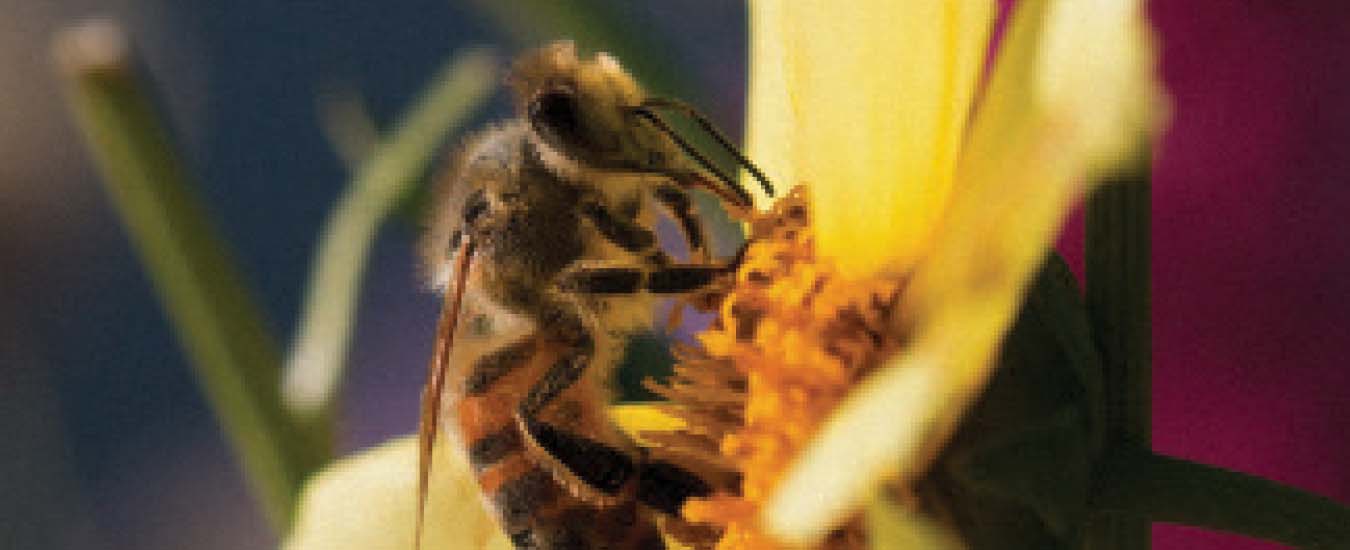How to help nature and beautify your yard all at the same time
There are a lot of reasons to plant a garden—for food, for beauty, for the pleasure of tending it, among other delights—but one of my favourite garden-related pastimes is watching. I spend hours peering into flowers, usually with camera in hand, or just sitting on a bench watching the pollinators at work. A calm, sunny day brings them out in droves—as early as mid- to late March in some cases—and there are as many different pollinators as there are plants. Maybe even more.
When we refer to pollinators, most people immediately think of the particular type that gets a great deal of attention in the press—honeybees. These are perhaps the best-known type of pollinator, but they certainly aren’t the only important one, nor the only species that is having difficulties. Native bees such as bumbles, mason, and sweat bees, bee-mimic flies (syrphid flies), butterflies, hummingbirds, even some beetles all play roles in pollinating flowers of crops and other plants. All of them can use a little help from their human friends. Hence, the pollinator-friendly garden has been gaining popularity with homeowners everywhere, as well as at many schools around the region.

Purple centaurea: Mountain bluet (here seen in cultivar ‘Amethyst Dream’ are long blooming, sunloving perennials for pollinators.
Creating habitat
One of the biggest threats to pollinators is habitat destruction, whether through agriculture, forestry or urban development. However, recognizing the need to share their land with beneficial creatures, more and more farmers create or otherwise maintain wildlife habitat between their fields, reducing the use of plowing and pesticide use where practical, and using cover crops to help keep soil health up as well as reduce erosion and encourage pollinator biodiversity. And a gratifying number of gardeners are planting with our pollinating friends in mind, leaving wild areas at the edges of their gardens where possible, avoiding pesticides, and even encouraging or at least leaving alone wild plants such as dandelions and clovers in their lawns.
Commercial pesticide use is strictly regulated in many locales around our region, and home use of pesticides discouraged or prohibited in many communities. It’s important to be aware, however, that even organic farmers sometimes use pesticides when dealing with crop disease or pest issues, and the products they use can be as toxic—or even more so—to bees and other beneficial insects as those used by conventional farmers. Most responsible producers do their best to limit pesticide exposure to pollinators by timing their spray applications so that there is minimal drift and minimal chance of most bees and other beneficials being active. After all, they want good crop production which requires good pollination by our winged friends.
I rarely have anything good to say about lawns, because they are essentially monocultures: water-sucking, fertilizer-and pesticide-needing, time-consuming wastelands that don’t contribute much of anything to a yard or garden except some green colour. If you must have grass (I acknowledge it’s useful for children and pets to play on, and for footpaths), consider reducing the lawn size in favour of additional shrub and perennial plantings, and/or adding some clover to the grass mix. Clover doesn’t require as much mowing, makes its own soil nutrients, tends to stay green, and of course, produces flowers that bees adore.
In your garden, it’s a great idea to have some sheltered locations out of the worst of prevailing winds; these offer a warmer spot for bees, butterflies and flower flies to nest, rest and search out food from pollen and nectar sources. A shallow saucer, filled with sand and moistened with water provides a place for bees and butterflies to sip moisture without getting their wings wet.
Bee houses are attractive nesting sites to some bee species, but others tend to nest in the ground; if you find a spot in your yard with a lot of native bee activity and small holes in the ground, consider leaving that area alone for the bees to nest in. In all my years of gardening, I’ve never been stung in my garden except for the time I stepped on a bumble in my bare feet! While it may cause the very tidy gardener to twitch a little, consider leaving the stems of grasses and tall perennials standing over winter and well into spring—these are often host location for overwintering stages of bees and other beneficials. Many are also great for adding winter-interest (and good photography opportunities) while we wait for spring to come again.

A fritillary butterfly lands on Echinacea ‘Evening Glow’ to search out its supper.
Natives or introduced?
There are some gardening enthusiasts who are adamant about planting only native species of plants, to help nurture native pollinators. While this is commendable, it can be somewhat limiting—and it’s not necessary because many native bees, flies, butterflies and birds have adapted to seek out food from non-native plant species; the humble dandelion is one such example. While I dig it out of my garden beds every spring, I simply let it do its thing in the lawn (along with clover, hawkweed, buttercups and whatever else takes root in among the grass) because it is such a great bee-magnet.
It’s good to avoid known invasive plant species in your garden, even if they are good food sources, because they can certainly crowd out beneficial plant species; but invasiveness varies depending on where you live. In the UK and much of the US, as well as warmer parts of Canada, Buddleia (butterfly bush) is an invasive plant even though it is a banquet for pollinators. In our region, however, Buddleia can be marginally hardy and often doesn’t even survive over winter.
If you’re planning a new area of your garden, remember that blocks or drifts of one colour/species is more effective than the scattershot multicolour approach. Insects see differently from mammals—and often see some colours better than others—so a block of bright purple or yellow flowers is more eye-catching than a medley of colours all mixed in together. Planting three of one colour-type of perennial together will make an effective drift, or if you’re patient, it only takes a couple of growing seasons for many perennials to get to a good size. Baptisia, for example, a relative of lupins, becomes like a large rounded shrub in just a couple of years.

In order to have Monarch butterflies, you need to have milkweeds for them to lay eggs and for the caterpillars to feed on.
Plants and more plants
It’s especially important to remember that warm days in late winter will often bring out bees and other pollinators, hungry and in search of food sources. Plants like Pulmonaria (lungwort), hellebores, willows and witch hazel (Hamamelis) as well as many of the spring-flowering bulbs are especially helpful to those early risers. Likewise, our long pleasant autumns keep insects active until well into October or even November, so later-blooming plants such as asters, New York ironweed (Vernonia) are also important to include in your design.
Many local nurseries around the region have sections for pollinator-friendly plants, and can help you round out your garden with nectar- and pollen-rich plants for the whole season. Lloyd Mapplebeck operates Hillendale Perennials in Hilden, NS and is a regular vendor at the Truro Farmers Market. He grows perennials as well as containerized salad greens, herbs, flowering bulbs and annuals, and is always keen to promote pollinator gardening to anyone interested in expanding their understanding. A photography enthusiast as well as a tremendous plantsman, he regularly posts photos of pollinators on his plants to help inspire others. “If I want to photograph a bee or other pollinators I usually go to Monarda (bee balm), tall sedums, blazing-star (Liatris), Joe-pye (Eupatorium) or Echinacea; they will have pollinators on them most of the time when in flower. The other plants around our place that always seem to have bees include flowering crabapples, crocus, marigolds, and sunflowers.”
Michelle Muis teaches in the horticulture program at NSCC Kingstec campus in Kentville, NS. When asked what plants she would most recommend for gardeners wanting to nurture perennials, she doesn’t hesitate. “Crocus, for the early-rising bees and others,” she says. “Chives, because they are so easy, will spread nicely, and can be used as underplantings around shrubs as well as in cooking, and of course any of the Asclepias (milkweed) species because they especially attract and help Monarch butterflies in all stages of their life cycles.”
Early season plants (from late winter to mid-May) include marsh marigold (Caltha), various willows, Fothergilla, early rhododendrons, bleeding hearts (Dicentra), Solomon’s seal (Polygonatum), columbines (Aquilegia), Bethlehem sage (Pulmonaria), flowering crab, quince and almond, serviceberry (Amelanchier) and early lilacs.
From mid-May until midsummer, add peonies, poppies, mountain bluet and relatives (Centaurea), astilbes, salvias, speedwells (Veronica), pinks and sweet William (Dianthus), false indigo (Baptisia), blue star (Amsonia), herbs such as borage, lavender, chives and comfrey, sea holly (Eryngium), globe thistle (Echinops), bee balm (Monarda), and the very important echinaceas and milkweeds (Asclepias). Try ornamental clover, Trifolium rubens, for a handsome and unusual perennial that is a magnet for most pollinators. Vines such as honeysuckle and hardwood trees such as lindens and magnolias are also excellent choices. And don’t cut the flower stems off your hostas—bees and hummingbirds love these white or purple, and often fragrant, tubular blooms.
Later-season plants include butterfly bush (Buddleia), buttonbush, (Cephalanthus) blue spirea (Caryopteris), summersweet (Clethra) and reblooming lilacs; lacecap-type hydrangeas (these have both sterile and fertile flowers in their flowerheads, whereas other hydrangeas don’t offer much for pollinators), New York ironweed (Vernonia), asters both wild and domesticated, fall sedums (both creeping and tall varieties), chocolate boneset (white-flowered Eupatorium), blazing star (Liatris) and ornamental goldenrods (Solidago) are also excellent choices for late season colour and pollinator feeding.
Additional reading resources
While you’ll find many short articles and websites online that provide information about gardening for pollinators, if you’re really interested in learning more about the science of gardening for these creatures, as well as about the many species that pollinate, books are the best option. Some great titles include:
Pollinator Conservation Handbook by The Xerces Society
Attracting Native Pollinators by The Xerces Society
Pollinator Friendly Gardening by Rhonda Fleming Hayes
The Bees in your Backyard by Joseph Wilson and Olivia M. Carrill
